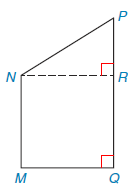
Jon S. answered • 03/09/21
Patient and Knowledgeable Math and English Tutor
a)
NR is parallel to MQ because <NRP and <MQR are equal corresponding angles, so that MNRQ is a parallelogram. Because consecutive angles of a parallelogram are supplementary, MNRQ is a rectangle.
Because PNR is a right triangle, <RNP and <P are complementary, ie., m<RNP + m<P = 90, so
m<RNP = 90 - m<P
m<MNR + m<RNP = m<MNP
m<MNR = 90 so
90 + m<RNP = m<MNP
since m<RNP = 90 = m<P and m<MNP = 58 + m<P:
90 + 90 - m<P = 58 + m<P
solve for m<P:
122 = 2m<P
m<P = 61
b)
QR = MN = 14 because opposite sides of a parallelogram are equal
NR = MQ = 15 for the same reason
Since PQ = 22 and QR = 14, then PR = 22-14 = 8
By the Pythagorean Theorem: NP, the hypotenuse is sqrt(8^2 + 15^2) = 17





